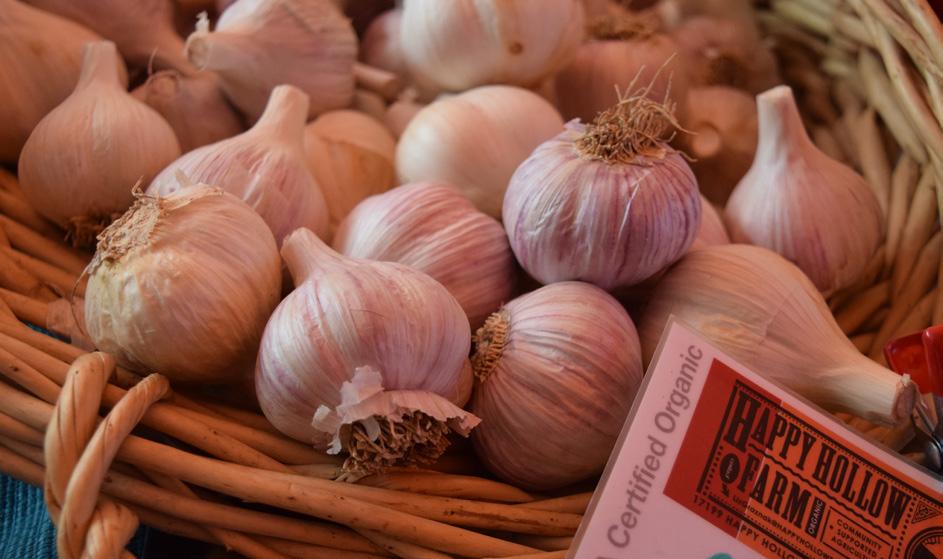THE STEAKS ARE HIGH

Beef prices are on the rise, but without the market stability to match, Missouri farmers have a beef with inflation. Page 22















Beef prices are on the rise, but without the market stability to match, Missouri farmers have a beef with inflation. Page 22













Journalists are very good at finding the bad news. Our pursuit of truth in the name of informing the public often means we uncover troubling information. If it’s overwhelming for you to read, it’s also overwhelming to produce. Fortunately, we also know how to find the good news. Silver linings can be a cheesy way to view the world, but if you know where to look, there’s a positive influence waiting to be found.
Kathy Gilsinan took this idea and ran with it in her book The Helpers, a series of profiles on people from the front lines of the COVID-19 pandemic. The profiles toe the line between heartwarming and heartbreaking, but regard less, they show the triumph of the human spirit. Gilsinan found her inspiration from a Mr. Rogers quote. (Yes, the neighbor-loving, zip-up cardi gan-wearing Mr. Fred Rogers.)
“When I was a boy and I saw scary things
in the news, my mother would say to me, ‘Look for the helpers,’ ” Rogers said. “You will always find people who are helping.” The first time I heard Gilsinan describe the concept, it seemed like a no-brainer. In times of upheaval, there’s an almost child-like instinct to check for the selfless people providing shelter and care. So, Vox decid ed to seek out and highlight the helpers in town.
Columbia’s helpers take on life’s challenges and help people through them, from a local librarian guiding people through a new tech nological world (p. 17) to a facility dog making pediatric therapy a paw-some experience (p. 21). Brianna Lennon and Boone County poll work ers are dedicated servants to the civic process, making elections run as smoothly as possible (p. 7–9). As you read our stories on Columbia’s helpers, think about who the helpers are in your life. Look for them. Help them, if you can. Thank them.
EDITOR-IN-CHIEF JANAE MCKENZIE MANAGING EDITOR ABBEY TAUCHEN DEPUTY EDITOR REBECCA NOEL

DIGITAL MANAGING EDITOR MARISA WHITAKER
AUDIENCE ENGAGEMENT EDITOR KATELYNN MCILWAIN
ART DIRECTORS HEERAL PATEL, MOY ZHONG
PHOTO DIRECTOR MADI WINFIELD MULTIMEDIA EDITOR HALLE JACKSON ASSOCIATE EDITORS
CULTURE SOPHIE STEPHENS, AUSTIN WOODS EAT + DRINK JULIA EASTHAM, GRACE LEYDEN CITY LIFE KARLY BALSLEW, JORDAN THORNSBERRY STAFF WRITERS JESSE BERLIN, LAUREN BLUE, KARA ELLIS, ATHENA FOSLER-BRAZIL, TATEN JANES, JACEY JOHNSON, EMMA LINGO, CHLOE LYKKEN, JOE MILLER, GRACE ANN NATANAWAN, MARJAI NEAL, AMILEE NUZZO, PETRA RIVERA, SYDNEY SCALIA, KHALIA SMITH, JANE STEINBRECHER, ABBY STETINA
SOCIAL & AUDIENCE ANNA TIERNEY LEGGAT, MELANIE OLIVA, DAVID LYNN TALLANT, MADI WINFIELD
CONTRIBUTING WRITERS SOPHIA DONIS, ANGELINA EDWARDS, OLIVIA MAILLET, ALYSE PFEIL, NATALIE-ELIZABETH TAN, LUCY VALESKI ART ASSISTANTS SIREEN ABAYAZID, CAMPBELL BIEMILLER, GRACE LEYDEN EDITORIAL DIRECTOR HEATHER ISHERWOOD EXECUTIVE EDITOR LAURA HECK
SENIOR EDITORS CARY LITTLEJOHN, JENNIFER ROWE OFFICE MANAGER KIM TOWNLAIN

A few of Columbia’s helpers came in to our studio for a photo shoot for this month’s helpers feature, including Blaze, the facility dog. Ever the professional, Blaze sat still with the help of his handler. She led him into the chair using a cheese stick and also brought along one of his toys. — Rebecca Noel

Sign up to receive Vox ’s weekly newsletter, the “Vox Insider.” We’ll tell you how to fill up your weekend social calendar and keep ahead of the trends. Sign up at voxmagazine.com.


CALENDAR send to vox@missouri.edu or submit via online form at voxmagazine.com
ADVERTISING 882-5714 | CIRCULATION 882-5700 | EDITORIAL 884-6432
NOVEMBER 2022
24, ISSUE 9

BY THE COLUMBIA MISSOURIAN
HILLS HALL, COLUMBIA MO 65211
Cover design: Heeral
photo: Amy Schaffer
Janae McKenzie Editor-in-Chief
Learn how Pierpont General Store has evolved over the decades from a grist mill to a bar and restaurant.

Boone County Clerk Brianna Lennon takes us through the election process.
Meet the poll workers who make local elections work.
Columbia-based sticker artists share their creative art inspirations.

High schooler Brianna Keingatti tells her dance journey and how she won Senior Best Dancer.

Meet some of the people, organizations and one canine companion dedicated to making Columbia a better place.
With increasing prices and decreasing cattle, Ben Thomas reveals the hardships within the cattle industry.
Local Instagram influencers share their favorite CoMo tasty finds.
Up clove and personal Missouri experts dig up everything you need to know about garlic.

Merriam-Webster added new food words to its dictionary this year. Here’s where you can find them in Columbia.
Ready for a new tattoo? True Heart Tattoo owner Jake Bailey wants to help.

Introverts and extroverts alike will love this roundup of local bar events.
 4
Photography by Jacey Johnson and Erin Martise and courtesy of Brianna Keingatti and Brittani Turmo and illustrations by Moy Zhong and courtesy of Michelle Marcum
4
Photography by Jacey Johnson and Erin Martise and courtesy of Brianna Keingatti and Brittani Turmo and illustrations by Moy Zhong and courtesy of Michelle Marcum
Pierpont General Store provides a glimpse into the past while giving way to modern features.
BY MARJAI NEAL
A bar and restaurant that sells Shake speare’s Pizza, two 24-hour gas pumps, a modern patio with enclosed seating and rows of tables and chairs in a landscaped courtyard — Pierpont General Store didn’t look this way 133 years ago.
Located at the main entrance of Rock Bridge Memorial State Park on Missouri 163, Pierpont is a hidden historical site. The original building was razed in 1889, but the store itself has been providing goods and services to residents of the village of Pierpont and city of Colum bia since 1960.
Pierpont General Store, named af ter the French word for rock bridge, has transformed from a mill to a blacksmith shop and now operates as a convenience store, restaurant and bar.



Initially, Pierpont was a grist mill,
Photography by Leanne Tippett Mosby/Archive and courtesy of UnsplashOwners Jed and Brandy Taylor purchased Pierpont General Store in August 2019 and added the bar, cafe and outdoor seating in the summer of 2020.
grinding grain into flour for neigh boring farmers who produced wheat. Surrounded by other buildings and es tablishments, the store stood the test of time, transforming from a mill to a dis tillery, producing whiskey. The property was then renovated into a paper mill, where it produced paper for the daily newspaper at the time, which operated from 1870 until 1913, Pierpont’s general manager Andy Clubb says.
The building has been home to sev eral businesses, yet many families lived and raised their children in the estab lishment over the years.
The 1960s changed the trajectory of Pierpont General. Several upgrades were made to the structure of the build ing. Not only could someone purchase groceries and everyday necessities, but travelers from all over could also benefit from the store’s new gas pump.
Almost 60 years later, Jed and Brandy Taylor purchased the property with hopes of breathing new life into it. “It hadn’t changed a whole lot until August 2020,” Clubb says. “That’s when we did all the remodeling.”
That year, Pierpont received a mod ern makeover. A bar and restaurant was built in addition to a patio where cus tomers could sit outdoors and enjoy their food with live music.
“We built on the deck, did some landscaping and put up a bandstand and started having bands come every Friday and Saturday night,” Clubb says.
During the day, customers can buy the staples, such as bread, milk and al cohol, and then grab a coffee to drink while sitting on the deck. At the night, customers can order the popular turkey and provolone sandwich, sip on a Moscow mule and watch traveling bands perform in the new bandstand. Pierpont’s makeover has garnered so much attention that the store had to rent the empty lot next door for additional parking.
The present Pierpont has evolved and changed with the times. Pierpont’s Facebook page now has over 8,000 followers, and its website has a monthly calendar that showcases the events that will be hosted on the property. Clubb credits Pierpont’s on line presence as the reason behind the resurgence of interest in the location.
“More people know about us now than they did before,” Clubb says. “I don’t think people realize they could have an event here until they see it.”
Chloe Fischer laid eyes on Pierpont General Store and saw potential. An out door enthusiast and Columbia native, Fischer looked all over for an event space to host her wedding reception. When she stumbled upon Pierpont, the property immediately caught her eye for its open and airy courtyard and its affordability.
“Pierpont stood out to me because it is unique and not a lot of people use it, and it’s an up-and-coming spot,” Fischer says. “Other venues weren’t our vibe. We wanted a more chill and welcoming place for people.”

Pierpont General Store serves brunch, lunch and dinner. The bar offers a rotation of wine and on-tap beers.
Pierpont General Store has left a last ing impression on residents and contin ues to build on a legacy that extends its 133-year-old history. Spread over 2 acres, the property has evolved with the needs of the people it serves.
“It’s just a great little place in the country,” Clubb says. “People just love Pierpont.”
 Photography by Valeria Zakharyk
Photography by Valeria Zakharyk
Brianna Lennon takes us through a step-by-step look behind conducting elections.
 BY JESSE BERLIN
BY JESSE BERLIN
It’s almost that time of the year again: Election Day. Come Nov. 8, Boone County residents at 73 polling locations will fill in bubbles and walk out with “I Voted” stickers. Oth er voters will do their civic duty with a stamp and an envelope.
Boone County Clerk Brianna Lennon, who was elected in 2018 and is on the ballot this year, administers elections. She previously served in the Missouri Secretary of State’s office as Deputy Director of Elections.
Election administrators have always had to deal with people questioning re sults says Eric Fey, election administra tor and Democratic director of elections for St. Louis County. Questioning cred ibility has been amplified since 2020, following former President Trump’s accusations of a stolen election. “It’s a little bit of a helpless feeling but I think election administrators have been trying very hard to, within their own commu nities, assure the public that the election system is secure and works properly,” Fey says.
Lennon talks with elections operate.
What are the first steps in conducting an election?
We know what’s going to be on the bal lot. That comes from a combination of places: the Secretary of State’s office tells us all the federal and the state things, but then if a city wants to put something on, we get that, too. We have to lock down all of our polling places and make sure that we have enough locations available. While that’s all happening, we are recruiting and setting up our training for poll workers.
Once the ballots are created and printed, we take a good number of them, randomly drawn from the ballots that we have printed. We create a test
Photography by Bailey Stoverdeck that then gets run through ev ery single voting machine that we’re going to be using on the election. It’s logic and accuracy testing that we do three to four weeks before the elec tion, and anybody can come. It’s con ducted by bipartisan election judge teams. And then we check what the results are on that machine against the hand-counted results of the test deck and make sure that they’re a 100% match.
When the polls close, the
door of the machine that has a seal over it all day. There’s a USB stick in there. They close down the machine, take the USB stick out, take all of the paper ballots, put those in a bag, seal up the bag and together, the bipartisan election team drives in the same car to our office with the bag of ballots and the USB stick. Those get checked in by our staff downstairs, and then we have a bipartisan team that walks the USB stick up the stairs into our count ing room, which has all glass walls and windows. That’s also open to the public. You can watch what’s happening. And those USB sticks get inserted into our election tabulator computer, which is not connected to the internet. Once they’re all counted in, those are con sidered the unofficial results that are
About a week after the election, we have our certification process, where we have another bipartisan team of judges that come in. They take 5% of our precincts. They will hand count those ballots, just to make sure that the hand count matches with the machines’ count 100%. Once we are satisfied that the machines didn’t make a mistake and everything has been counted correctly, then we actually certify the elec tion. Those are considered the final results.
It is a community-led pro cess that everybody is en titled to participate in, and we hope that more people participate in it because it helps us to conduct the election. The more people that we have that we can involve in the process, the better the process is.
“It doesn’t matter how rich you are or where you live,” says Boone County Clerk Brianna Lennon. “Your vote counts the same as anybody else’s.”
TUNE IN Listen to Lennon and Eric Fey’s election administration podcast High Turnout Wide Margins on Spotify.
Local poll workers share what it takes to ensure elections go off without a hitch.
 BY JESSE BERLIN
BY JESSE BERLIN
For most of us, voting is a simple procedure: We go to a polling lo cation, fill in our responses and feed our ballot into a machine. Sometimes we send our ballots through the mail. But that process is the culmination of a multi layered, collective effort to get your ballot tallied.
Election administrators are the peo ple who make this possible. First, there are poll workers — the people at polling places, interacting with the public and making sure everyone has everything they need to vote. Then, there are poll worker trainers who teach volunteers what it takes to be a poll worker on Elec tion Day. Finally, poll worker supervisors are another crucial part of this system. Much like shift managers, they make sure the polling places run smoothly and, most importantly, transport ballots to the local election authority.
Amidst recent discussions and de bates over election integrity, these three
local election administrators are at the forefront of voting. They share insight into why the electoral process is import ant to them.
Role: Poll worker, trainer, supervisor Started in: 1986 Day job: retired
After diving into American Legion Aux iliary Girls State (a mock state govern ment) while attending Centralia High School, Gina Newby’s interest in civ ics was ignited. But she didn’t want to run for public office during the mock government. Instead, she wanted to help people vote, and assumed the poll worker role.
After high school, Newby wanted to get out of the house, and felt inspired after seeing a newspaper advertisement about poll work. “I was like: ‘I know what that is. I can do that,’ ” she says.
Election administrators ensure that polling places run smoothly, which involves familiarizing others with new technologies.
Jan Loudenslager explains the new touch screen voting system in the Boone County Polling Center. This makes voting more accessible for those with disabilities.
Newby is still working at the polls 36 years later because she enjoys the people. Working in the same precinct where she lives, she now finds herself at the center of community bonding. “I had people come up and couldn’t resist and gave me a hug saying: ‘I’m so glad you’re here,’ ” she says. “It’s that kind of one-on-one with your neighbors and your friends that are in your community that just makes your day.”
Newby says the community aspect of the work gives her even more incen tive to make sure everyone gets a chance to vote. During the primary election in August, some voters’ names were left out of the database due to a technical glitch. Still, she ensured they could vote with provisional ballots. “At least they had the opportunity to cast a ballot, and it would be verified,” she says. “That makes me comforted to know that they have a chance, that it counts, and I did all I could to help them out.”
Photography by Kennedy McGilveryRole: Poll worker, supervisor
Started in: 2016
Day job: software configuration engineer
Relatively new at election administration, Beth Kelly became a poll worker during the 2016 election after signing up on the Boone County website. “That seemed like an especially important election to have fair and available polling,” she says.
Kelly says she was fascinated to see how the other side of the voting process works, having been a voter multiple times before. “It’s a long day,” Kelly says, “and I was still so energized by the end of it.”
After becoming a poll worker su pervisor in August, Kelly does a lot of the same tasks as a poll worker but with an added level of responsibility. Now she’s tasked with opening and closing the polling location, prepping the machines for Election Day and transporting the ballots to the county clerk’s office.
Although she hasn’t been working
If you’re interested in being a poll worker, visit the Missouri Secretary of State’s website to sign up. Your local election authority will contact you, and you’ll attend at least one training session four to six weeks before Election Day. Poll workers are needed for the election on April 4, 2023. For more information about being a poll worker, visit the FAQ at sos.mo.gov/ pollworker/faqs.
elections very long, Kelly still sees the impact of her work whenever she’s there.
“To see people who come in and un derstand that’s part of what they do for the republic, that’s great,” she says.
After returning to Missouri to be closer to his father, Scott Joffe met Art Auer, the Boone County director of elections, through his place of worship. He subse quently became a poll worker because he enjoyed meeting people and helping them vote.
Joffe says that voters’ political orien tations are irrelevant to working the polls. He says he’s just there to do his job.
“Being part of the election process, (enables) people to share their voice,” he says. “Politics really doesn’t play any effect on that. When you’re in the polls, you’re not allowed to talk politics at all. You’re
there to make sure people vote.”
Joffe is the one who asked Kelly if she’d be interested in election supervis ing. They met while working at the same polling location during the 2022 mayoral election. Joffe is the Republican supervi sor, and because every polling location needs a supervisor representing both major political parties, Kelly became the Democratic supervisor.
Joffe says he’s sure that voters can trust the electoral process and all the steps and precautions that are taken to ensure election integrity. He encour ages those who have doubts to sign up to be a poll worker and learn about the process themselves. In fact, he said he knows former skeptics who did this and subsequently changed their minds.
“All those people came back and said, ‘You know, now I understand why I can’t be right,’ ” he says. “It’s just not possible that fraud could be committed with all of the controls that are in place and all the systems of seals. It just can’t be done.”

4:00—7:00pm Wabash Station
7:00pm Corner of 9th & Broadway discoverthedistrict.com
The kickoff of the Art District’s three new installments in the North Village Arts District Walk. First, check out the fence alongside Park Avenue that will be covered in artwork by vari ous local creators. Then gaze at the new lit sign on the archway truss near Artlandish Gallery that exclaims “Art Lives Here!”. Finish your walk on Walnut Street to see a new bronze sculpture titled “The Gymnast” by artist Larry Young. Grab some hot chocolate and take a stroll for the First Friday in November. 6–9 p.m., Nov. 4, North Village Arts District

Each month, Vox curates a list of can’t-miss shops, eats, reads and experiences. We find the new, trending or underrated to help you enjoy the best our city has to offer.
BY JANE STEINBRECHER



An evening of dance with Mareck Center for Dance’s annual fall show, Unleashed. Formerly known as the Missouri Contem porary Ballet, the Mareck Center has nine profes sional dancers from all over the U.S. Enjoy artistic ex pression through diverse dances and three world premiere performances. 7 p.m., Nov. 11 and 12, Mis souri Theatre, 203 S. Ninth St., $24 to $48

To a variety of musical performances at the Columbia Experi mental Music Festival. The artists featured on this year’s lineup incorporate several cutting-edge techniques such as feedback and si lence. Films and documen taries will also be screened alongside the eclectic jams. Expand your musical hori zons with this fest featuring headliners like R.A.P. Ferrei ra, Haii Usagi, MANAS and Estrella. Times vary, Nov. 2-6, multiple venues, tickets range from $25 to $100. Learn more at cargocollective.com/dismal niche/2022-CEMF
At The Food Bank for Central and Northeast Missouri’s 21st annual Thanks giving donation marathon. The Partnership Against Hunger helps ensure families in Columbia have access to food on Thanksgiving. The Food Bank will accept donations at Hy-Vee and Schnucks locations, along with monetary donations on its website. Gather your friends and family to help out and get into the true spirit of the holi Donations accepted 6 a.m. to 6 p.m., Nov 22, Schnucks and Hy-Vee locations. Most needed items include canned meat, fruits and vegetables, beans, rice, cereal, peanut butter, soup and pasta
With barbecue at the family-owned and operated Como Smoke and Fire, where “it’s never a disgrace to have sauce on your face,” according to its website. A new location is underway on Buttonwood Drive in the former Buck ingham Smokehouse location. With an anticipated fall opening date, soon Columbians will have double the chance of enjoying Smoke and Fire’s classic barbecue. 11 a.m. to 8 p.m, Tues.–Thurs.,11 a.m. to 9 p.m., Fri.–Sat., 4600 Paris Road

This collage features stickers created by Michelle Marcum, Haley Coyle and Max Kelly. All three artists use the medium as a way to express and share their points of view creatively.
Meet Columbia’s sticker artists and learn how they got stuck on the fun art pieces that often live on laptops and water bottles.


 BY EMMA LINGO
BY EMMA LINGO

Look around you. Whether you’re on a college campus, at the gym or even in your own home, you’ll likely see little pieces of artwork slapped onto wellloved laptops or emotional support water bottles. These stickers serve as a means of self-expression for the owners, but they’re also a creative outlet for the sticker creators.


Vox talked to three Columbia sticker artists about their design process, in spiration and how they started making stickers in the first place.



Michelle Marcum started out as a sand wich artist. As the store manager at a local Subway over a decade ago, she knew she wanted something else. So, Marcum be gan attending school online through the Art Institute of Pittsburgh and started pursuing an art degree at Moberly Area Community College in Columbia. This is when she discovered digital art.
Fast forward to the early 2010s, Marcum, now working under the name Art Chica, pumped out design after de sign. She got her real start in the art world in 2019, and she hasn’t left since.

Three-eyed aliens and glittering forest creatures made their way from her imagination to the page, and then to the streets of Columbia. Marcum says she sometimes sees her stickers on water






bottles when she walks downtown. Now that she’s doing graphic design and il lustration full time, she has come a long way from doodling in school notebooks and working at a sandwich shop.
“As a kid, I used to draw a lot, but then I’d get depressed and wonder why I’m doing this,” Marcum says. “Back then, I didn’t know art was what fed my soul. I create, and I love it. I want to share it with everybody.”
Stray from the path, Folks Haley Coyle often runs her illustration business, Stray Folk, from the floor of her baby’s room. She and her 6-monthold are inseparable. They lie outside on picnic blankets together, and Coyle also draws stickers while they nap in bed. She says it is hard to create art away from her baby and that combining mother hood with her artistry has made her feel fulfilled.
Coyle and her husband, Damon, are crafters. Coyle’s mother always had scraps on the dining room table for cre ative projects while Coyle was growing
up. Now raising her own child, Coyle is also fostering a creative household.
Between parenting and sketching, Coyle says she finds herself in nature more than ever. It’s where she met her husband while out on a walk, where she finds her happiness and where she finds her inspiration.
“It doesn’t have to be a vacation to the mountains; it can just be finding a new back road while I’m driving home,” Coyle says. “I used to get lost on purpose on my way home from work because I love trying to find new places.”
Art goes hand-in-hand with self-expres sion, and that’s what stickers are about for Max Kelly, who uses they/them pro nouns. Outta the Cupboard is Kelly’s full-time gig. They dedicate their spare time to Twitch streaming, participating in pop-ups and designing products for the next sticker launch.
Kelly originally wanted to be a stage manager or theater technician, but the pandemic threw a wrench in that dream.
In store: One-toOne Print Shop, 1610 Paris Road
Stray Folk strayfolkgoods.com
In stores: Plume, 5751 S. Route K and Poppy Made By Hand, 920 E. Broadway
In store: Distant Planet Comics and Collectibles, 601 Business Loop 70 W.

They ended up taking art courses at Moberly Area Community College af ter years of being self-taught and now run Outta the Cupboard.
Kelly sets up a booth at most Missouri Pride events, including the Mid-Missouri PrideFest in Columbia. Self-described as “a little sassy, a dash of nerdy and a whole-lotta queer,” Kelly loves to serve their own community of cosplayers, anime enthusiasts and boba tea fiends.
When Kelly isn’t engaging with customers in-person, they spend time on their Twitch stream showing their sticker designing and packaging process and teasing upcoming products.
“Outta the Cupboard started as me wanting to give a space to Pride identities that weren’t seen in corporate capitalism,” Kelly says. “We see Pride Month come around and the rainbows on everybody’s logos, and I noticed a distinct lack of various identities. It was all a rainbow or nothing. And it’s so important, in my shop, for somebody to see themselves (represented).”

Leading up to The Dance Awards, high schooler Brianna Keingatti was overwhelmed with self-doubt. But as a dancer since kindergarten, she knows how to stay on her toes.
BY LAUREN BLUEBefore winning the title of Senior Best Dancer at The Dance Awards this past sum mer, Brianna Keingatti says she found herself struggling mentally, physically and spiritually. It became difficult to express herself and explore emotions through dance like she had in the past. Feeling dis connected and numb to the world around her, she even questioned whether she had the confidence to compete for the best dancer title. But as soon as she took the stage, surrounded by others who shared her passion, her doubts subsided.
“Prior, I was so beaten, I felt so de feated, so to feel that type of joy was so refreshing,” she says. “It was nice to feel my love of dance really be sparked back, because for a second it was starting to die.”
When Keingatti started dance classes at Columbia Performing Arts Centre in
kindergarten, she was not a fan. Despite dance being a family affair, with her old er brothers dancing at the same studio and loving the art, she didn’t expect to last long in classes. Keingatti says her brothers were natural talents and that she was “terrible” when she was young.
Brianna’s older brother David, a sophomore at the Conservatory of Dance at State University of New York at Purchase and a former student of Jen Lee’s, the competitive director at Co lumbia Performing Arts Centre, says even though his sister is extroverted, she can be reserved when it comes to internal growth. “She’s vocal, but she’s quiet about how she grows, how she develops,” he says.
Keingatti continued to dance because she liked the environment fostered by Lee. Growing up in predominantly
Brianna Keingatti didn’t like dance at first, but once it clicked for her, it became a lifelong passion. “It was like an out-of-body experience,” she says of winning Senior Best Dancer.
white, Catholic schools, Keingatti felt unable to express herself. But in Lee’s studio, dance became a source of lib eration.
“At school, we tend to mold into a certain person because you want to be cool, you want to be popular, you want to fit some agenda that they have at school,” Keingatti says. “But at dance, we all strip everything that we take from school off of ourselves. We are literally brothers and sisters; we are so vulnerable with each other, and Jen creates that with us.”
Keingatti currently attends Rock Bridge High School. In addition to school, Keingatti arrives at the studio around 4:30 p.m. and practices un til about 9:45 p.m., Monday through Thursday. On Fridays, she has a ballet class, and on the weekends, she attends rehearsals where dances are perfected to the last detail.
Lee says Keingatti’s vulnerability and energy are the key qualities that set her apart from other dancers. “Her en ergy when she dances completely shifts the room,” Lee says. “You can tell that (dancing) is in her soul.”
In July, Keingatti beamed when she heard her name announced as the winner, and her entire studio stood up and cheered for her. The studio also took home Best Specialty Performance, Best Performance Winner and Winner Senior Duo/Trio. “It was life-changing,” Lee says. “When I’m hav ing a bad day, I’ll watch those videos of (the studio) winning because it’s just pure joy.”
Columbia Performing Arts Centre and Keingatti are currently preparing for their upcoming competition season — the grind isn’t stopping anytime soon. Keingatti plans to go to college for dance and aspires to be a triple threat, exploring singing and acting as well. “I don’t want to ever box myself into just dance,” she says. “I want to do everything.”
IT WAS NICE TO FEEL MY LOVE OF DANCE REALLY BE SPARKED BACK, BECAUSE FOR A SECOND IT WAS STARTING TO DIE.”
— Brianna Keingatti
“


In a world filled with disruption (a continuing pandemic, war in Ukraine, political divisiveness, climate change and natural disasters), Vox turns to those who offer assistance and hope. In our own neighborhood of Columbia, we remember Mr. Rogers’ advice to look for the helpers. These people — the social worker, the librarian, the recovery organization, the steward and the facility dog — spread a message of helpfulness, kindness and joy to our community.
“Look for the helpers. You will always find people who are helping.” — Mr. Rogers
 PHOTOGRAPHY COURTESY OF FLICKR
PHOTOGRAPHY COURTESY OF FLICKR


Home visitor Karla Jackson gives families the tools to create healthier homes.
BY JESSE BERLINSince becoming a social worker in 1986, Karla Jackson has worked with many types of families.

“Sometimes they’re single mothers, sometimes single mothers that have nobody else,” Jackson says. “I’ve literally had moms give birth in the hospital and have had to take a taxi cab home because there’s nobody in their family to come pick them up.”
In 2007, Jackson transitioned from working at a children’s mental health clinic to her current title as a home visitor, where she helps make birth and parenthood easier and healthier for all involved, from pregnancy to 3 years old.
As a high-risk prenatal and postnatal social worker for the Healthy Families program with Columbia Boone County Public Health and Human Services, Jackson works mostly with at-risk families, meeting people who are first-time parents, unhoused, living in their cars, have a history of abuse or neglect, or actively using drugs. They’re often too focused on getting their basic needs met to do things like attend appointments.
Jackson, mother of two, also knows how chaotic yet rewarding raising children can be. She under stands how a new parent feels when their baby wakes up and won’t fall back asleep, especially if the parent is alone.


“Having kids will make you feel like the most in competent person in the whole world at moments,” Jackson says. “It’s the best, most rewarding job in the world, but it can also be so overwhelming.”
During home visits, Jackson brings supplies that work to meet parents’ needs and keep their child or children on track to develop properly. These could be safety items such as car seats, sippy cups, highchairs, hygiene products like diapers and wipes, nursing pillows for breastfeeding or foam pads for floors so babies can have tummy time to build core muscles for crawling.
However, it’s not all about the child, Jackson says. It’s about the family as a whole. Along with supplies, Jackson provides parents with infor mation and guidance on parenting and navigat ing everyday life with a child at home. Jackson encourages caregivers to get into a routine of reading to their child.
“I’m a big book pusher,” Jackson says. One study by The Ohio State University found that children whose parents read books daily to them
have heard 1.4 million more words than kids who were never read to.
To make sure the child grows up in a healthy home environment, Jackson screens parents and other family members to monitor developmental issues and track relationship dynamics. She also serves as a parent’s advocate, such as being there with expecting mothers at doctors’ appointments and hospital visits.

Having someone there to be an advocate can not only help during the pregnancy but afterward as well, says MU Health Care OB-GYN Dr. Courtney Barnes. As a prenatal and postnatal care provider, she’s adopted a group support approach so mothers can go through pregnancy and raising a baby together.
“They’re helping each other out,” Barnes says. “They’re Facebooking each other in the middle of the night saying, ‘Anybody else up with a cranky baby?’” Barnes explains that group support has been shown to decrease health risks during pregnancy and birth, improve breastfeeding outcomes and reduce postpar tum depression. “It’s powerful what these ladies do for each other,” Barnes says.
Jackson has also helped parents navigate social services, which Jackson says can be a nightmare to deal with. It can take 100 days, for example, to get approved for Medicaid.
The Missouri Children’s Division Child Abuse/ Neglect 2021 fiscal year report stated that a total of 62,436 children were involved in one more re ports of abuse. According to the National Library of Medicine, parenting styles are passed down between gen erations. Jackson hopes she can help end the cycle of abuse, ne glect and negative childhood expe riences so those patterns aren’t repeated.
“It can be a real generational thing,” Jackson says. “Hopefully, they’ll have a better childhood expe rience, and they will be able to give that to their own babies when they grow up.”
Karla Jackson brings a sense of comfort to new parents.
When he was growing up in Columbia, Mark Swearngin visited plenty of libraries, but he didn’t realize their importance. After graduating from Hickman, Swearngin earned his undergradu ate degree at Minnesota’s Macalester Col lege, then moved back to Columbia in 2005. He learned the significance when he got his first job at the Columbia Pub lic Library in the circulation department in 2007, when more people were coming to the library for its free services and resources during a recession.
“I would see the lines coming outside the door for tax help,” Swearngin says. “I would see the families coming for story time. (I would) see people coming for the concerts we have or different programs we have. I thought, ‘Oh wow, people come to the library for a lot of things.’ ”
Swearngin’s first years at the circulation depart ment and involvement with the library’s communi ty inspired him to get a master’s degree in library science at Emporia State University in Kansas. “I knew then that I really needed to get my act together and go to school,” he says.
Swearngin started working as a public services librarian four months ago, specializing in helping visitors with technology.
Between his stints in circulation and as a pub lic service librarian, he delivered reading materials to homebound people and hosted story time for childcare centers in rural Boone County com munities.
Anne Gioruard, another public services librarian at the Columbia Public Library, says a librarian’s main role is to give people access to all the information and resources they need, and technology plays a big part in that. “We, I think, are a bridge for the digital divide,” she says.
Recently, a woman came into the library to meet Swearngin in an outlet-lined classroom to request help with transferring photos from her iPhone to a new laptop. Swearngin hadn’t worked with Windows 11 before, but he quickly figured it out.
Swearngin says it’s typical for people to ask for assistance with new devices they got as gifts. He fre quently gets questions from people who haven’t used a computer in years. “It’s easy to forget that there are a lot of people who have either never had access to a computer or don’t use them often, and now, they have to,” Swearngin says.
People of all ages come to the library for help with technology. One-on-one appointments are available during the two hours reserved for technology help every week, in the library’s Training Center on the second floor. Swearngin says his teaching style is fo cused on demonstration so that people can continue to follow the same steps on their own later, like when someone needs to send a fax on the library’s machine over and over again.
“We do a lot; we work really hard to build a repu tation that we are a place people can come to get help,” Swearngin says. “And that’s really what libraries, public libraries are – these places for people to come and get information on whatever they need.”
Check out these resources Columbia Public Library has to offer.
Notary: provided for free and located in the administrative office.
Passport: offers free applications for new applicants at the reference desk.
Interlibrary loan: statewide search for copies of requested materials not available at DBRL.

Downloading and streaming: audiobooks, music, TV and more offered with a DBRL card.

Outreach, home and community facility delivery: available for those who can’t visit due to illness, disability or age.
Wolfner Talking Book and Braille Library: free for those who are unable to read standard print.

Mark Swearngin helps a range of people who need help with technology.
 AMY SCHAFFER AND COURTESY
AMY SCHAFFER AND COURTESY
 FLICKR
FLICKR



The Missouri Coalition of Recovery Support Providers wants help Missourians experiencing substance use.
BY EMMA LINGOGreg Smith knew it was time to get help. Around 2006, his alcohol use cost him his job and nearly his home. His parents had moved to Spring field, Missouri, while Smith went north to Wash ington, D.C., to work as an attorney and lobbyist. Eventually, he reached his breaking point, and wanted things to change.

“I got sick and tired of being sick and tired,” Smith says.
To recover and make the transition from sub stance use to sober living, Smith knew it would be easier with help from his family. When he called to tell his parents he wanted to come live near them to start his journey to sobriety, they encouraged it.

Twelve years later, Smith started as the execu tive director of The Missouri Coalition of Recovery Support Providers, a position he has now held for three years. He calls the position his mission in life rather than his job. Through the organization, Smith has committed to helping people who are using drugs and alcohol.
So on Oct. 5, when MCRSP won Organization of the Year through the national Faces and Voices of Recovery Conference, he couldn’t wait to tell his team.
MCRSP is an organization that helps those suffering from substance use disorder. According to the organization website, MCRSP is “a network of faith-based, peer and community organizations that restore and rebuild lives and families seeking recovery from substance use disorders through immediate access and long-term relationships.” The group of helpers on MCRSP’s seven-person board has served over 70,000 Missourians and houses up to 1,800 Missourians experiencing substance use on any given night in accredited recovery homes throughout the state.
Since Smith took over in 2019, he hasn’t stopped pushing for the coalition’s success. MCRSP has expanded the board, secured $3.92 million in state funding annually in addition to federal fund ing, and launched several legislative initiatives. The goal is to make it easier for people to recover and find a support network.

While working on adding new board members this summer, Smith wanted Jamie Martin, a Columbia native, to come work for the organization. Martin, like Smith, is in long-term recovery. MCRSP created a new position for Martin — director of training and technical assistance. “Jamie checked all the right boxes, and most importantly, she has passion,” Smith says. “You can teach anyone technical skills, but you can’t teach them to care like that — like she does.”
Martin started in August and oversees 126 MCRSP partners and holds a position on the state-level with Missouri Behavioral Health. She offers guidance and tough love to the women she sponsors and gives targeted attention to the statewide network of recovery facilities.
Her hope, Martin says, is to connect all Columbia recovery facilities so that social workers can maximize their impact and those suffering from substance use dis order can receive top-notch care. “There’s no excuse,” Martin says. “We are Columbia, Missouri. We have every resource at our fingertips. Not everybody realizes that. We’re a wealth of knowledge and resources. It’s just about getting people the information.”
In addition to information dispersion through MCRSP, Martin uses her free time to provide recovery resources to those in the community. Within the past six months, outside of work, Martin says she has given away almost 144 units of Narcan, an overdose treatment that can be bought at pharmacies without a prescription.
Trey Dawson is living evidence of how MCRSP affili ates can do good. Dawson has served time at 27 county jails across 12 states and five penitentiaries in two states. He was released from prison for the last time on Christmas Eve 2019, and he graduated in six months from In2Action, an MCRSP program for those recently released from prison. He now serves as the organization’s activities coor dinator. “I do not have a desire to use drugs and
alcohol anymore,” Dawson says. “I never thought I would ever say that.”
Dawson met Martin at a support meeting shortly after his release in 2019. By then, Dawson had started planning to kickstart his own dog-training company, BackyardK9. Martin was his first customer. Or rather, her pup, Chip, was.
MCRSP’s outreach program has changed many lives. Sixty-two percent of its clients are either on probation or


parole. At their 6-month follow ups, 88% of MCRSP’s clients continued sobriety. Additionally, 90% of its clients completed the program with stable housing set up, and 63% of clients are employed. After leaving the program, 98% of clients are not arrested again.

“We believe in supporting people in all their different pathways to recovery,” Smith says. “Everyone has a unique, in dividual way of healing.”

Columbia’s MCRSP chapter, The Central Missouri Recovery Coalition, meets on the second Thursday of each month at 9 a.m. For a Zoom link to the meeting, contact Dan Hanneken at dan@ In2Action.org.




Dave Dittmer gives a behind-the-scenes look at supervising Columbia parks.
 BY PETRA RIVERA
BY PETRA RIVERA
Columbia is home to beautiful outdoor spaces. In fact, there are more than 42 parks within the city’s boundaries. The access we have to these spaces wouldn’t be possible without people who dedicate their life’s work to it. “Humans have a need for green space and experiences with nature,” says Dave Dittmer, the natural resources supervisor for the City of Columbia Parks and Recre ation Department. “Some people don’t really realize how important it is.” Dittmer oversees the Columbia departments of forestry and horticulture.
According to the National Recreation and Park Association, about 96% of U.S. adults spend time out doors daily, with more than half spending 30 minutes or more outdoors. The NRPA’s studies have shown that as little as 20 minutes a day outside reduces stress levels. According to the U.S. Department of Agricul ture, studies also show positive effects of being outside such as reducing muscle tension, heart rate and levels of cortisol, which is your body’s main stress hormone.
Some of Dittmer’s fondest memories are those spent outside growing up, like swimming in the summer and running around the community parks with his siblings. Eventually, his love of the outdoors inspired him to earn a degree in natural resource management at MU in 1998.
“Growing up, my parents were big on getting us out to the community parks, whether it was going swimming or going to playgrounds,” Dittmer says. “I remember by the time I was old enough to go for bikes rides by myself, I would explore neighborhood parks in St. Louis.”
After eight years of doing seasonal horticulture work around the country and becoming a forester in Columbia, he took a bigger role in the Parks and Recreation Department with his recent promotion to natural resources supervisor. He spends his dayto-day juggling meetings with Columbia residents, organizing future projects, doing reports to update City Council and assisting the forestry crew with the work they are doing in the parks. The parks and recre ation crews are responsible for tree planting and care, maintenance and upkeep of trails and landscaping of formal gardens in downtown Columbia.
Arborist Steve Fritz is a longtime colleague and friend of Dittmer. “His role with the parks department almost fits into his personality,” Fritz says. “Every time I see Dave, he’s got his next trip in mind. He spends a lot of time outside, backpacking as a climber and he’s always going out West. He’s an outdoors guy. And what’s a better place to work? Parks and Rec and the for estry department.”
Community is one of Dittmer’s biggest motivators for the work that he does, and a big part of his job is meeting with citizens of Columbia, specifically park volunteer groups. One of the groups Dittmer is part of is the TreeKeepers, which trains and educates volunteers about proper care and maintenance of trees. Another program is the Adopt-A-Trail pro gram, which is designed for volunteers to help maintain areas of the Columbia Trail System. Citizens can adopt quarter-mile of a trail to help remove invasive plants.
Dittmer also connects Columbians to parks and trails by dealing with public concerns and complaints. He says having high quality trails and nature areas are necessary.
Dittmer and his crew appreciate the people they serve, and it motivates them to continue to provide the best outdoor spaces they can. “There’s probably a lot of towns in the Midwest that don’t have that type of desire for green space and trails and nature areas,” Dittmer says. “But, the citizens of Columbia are the ones who pay the park sales tax that helps fund our de partment, with a higher percentage of the voters every time. That’s really neat that we do live in a communi ty that’s appreciative and passionate about what we do here.”
 PHOTOGRAPHY BY ANASTASIA BUSBY AND COURTESY OF FLICKR
PHOTOGRAPHY BY ANASTASIA BUSBY AND COURTESY OF FLICKR
Blaze the black Labrador works with children in various therapy.
BY JOE MILLERDuo Dog Blaze starts his work days at 8 a.m. He takes his medicine and vitamins from one of his handlers and awaits whichever kids need him.
Blaze is a facility dog at Children’s Therapy Center. As a facility dog, Blaze provides additional love to kids as they go through physical, occupa tional or speech therapy.
Kelsey Okruch, a manager at Children’s Therapy Center, is one of Blaze’s handlers who helps him start his day. “The smiles that Blaze brings to people’s faces are frequent and often,” Okruch says. “Blaze has been an exciting thing that makes it not such a chore to come to therapy.”
Amy Jeffers’ son Levi has cerebral palsy, a chronic lung condition and suffers from low muscle tone. Part of Levi’s physical therapy has been learning how to use crutches. A motivator for him was being able to lean forward on crutches in order to play fetch with Blaze. “Levi, when he’s doing things with Blaze, he forgets he’s in therapy. He’s a boy play ing fetch with a dog,” Jeffers says.
Blaze is a black Lab who came to Children’s Therapy Center from Duo Dogs Inc, a non profit organization in St. Louis that has placed over 200 assistance dogs across the country.
Duo Dogs trains and connects dogs with people to cultivate positive change in indi viduals, families and communities. According to Duo, facility dogs are placed with medical, legal and educa tional organizations. Assistance dogs are trained to work with individuals.
Sometimes kids have tough times with physical therapy, and it can be a struggle for them to get in the right emotional state to face therapy and treatment.
“If Levi’s going in with a bad attitude, you’re hardly going to get anything out of it,” Jeffers says. Blaze is a re source in those moments.

His presence is calm ing, and he offers extra emotional support. Ac cording to the American Kennel Club, therapy and facility dogs provide physical benefits to hu mans, including reduced anxiety and lower blood pressure and heart rate.
Additionally, Blaze adds fun to therapy. Blaze has engaged Levi in lightsaber battles with pool noodles, hide-and-seek and playing on the playground.

Aside from emotional support, Blaze helps with different aspects of pediatric therapy. He has a tooth brush and helps kids learn how to brush their teeth by letting them practice on him. He also has socks that he will wear for kids who are learning how to dress. His favorite activity is feeding therapy, which is when kids learn how to use utensils and practice with some dog treats.
Facility dogs like Blaze are bred for these roles. They undergo socialization training for the first 18 months of their lives. After that, these dogs are trained further to become either service or facility dogs.
Although the Children’s Therapy Center is a pe diatric center, Blaze also aids the adult full-time staff in the office. He swings by offices to cheer up the staff, but he might ask for a pet in return.
“He often sits at your feet when he comes over,” Okruch says. “He will take naps in his crate, but if there’s people around, he likes attention and to be petted.”
Blaze might be young — he turns 4 in February — but he does crucial work at Children’s Therapy Center. His impact shows in the number of smiles around him. This Halloween, Levi Jeffers’ costume will be Blaze the facility dog. “In the end, he’s just motivat ing Levi to do all of his work,” Jeffers says. “They’ve been good buddies.”
PHOTOGRAPHY BY OWEN ZILIAK AND COURTESY OF FLICKR



Cattle farmer Ben Thomas starts his work at sunrise. He throws empty bags of nutritional minerals into the back of his utility terrain vehicle. Minerals are just one of the operational costs for his Hereford and Black Angus cattle. Thomas’ herd gathers around the remaining bags of feed at his farm in Trenton, Missouri.

In stores, beef prices are going up. But amid rising farming costs and a fickle market, farmers aren’t reaping the benefits.
When Ben Thomas was 17, he wasn’t sure what he wanted to do with his life, but there was one natural choice. His dad was a farmer, whose dad was a farmer, whose dad was a farmer. He was part of the National FFA Organization at Tren ton High School. All his life, he helped his family with its cattle and crops. So, when a few farms in their community went up for sale, his dad urged him to buy the one with a little old farmhouse on the property, and he listened.
At the time, the 200-acre plot of land cost $1,000 per acre. Thomas says the price today would be “crazy high,” around $7,000 to $8,000 per acre. But when he purchased his property in the ’90s, he had no idea what the cattle in dustry would be like today.
Average family meals that incorpo rate beef are ringing up at higher and higher prices. According to the U.S. Bureau of Labor Statistics, beef prices at grocery stores are up 20% in the last year. American beef production is an ever-growing $79 billion industry, but Thomas’s cut of the cash has not been increasing. Although the cattle them selves are not selling for a higher price, the cost of items needed to sustain a farm has significantly increased.
For Thomas, that high price is not translating into higher profits, nor is it helping him cover the steep expenses of fertilizer, gas and feed. These and other

farm-essential costs have gone up expo nentially over the past two years.
In March, The New York Times re ported the majority of fertilizers in the world have doubled or tripled in price over the past year, as a large portion of the world’s fertilizer is stuck in Russia and Ukraine. Russia is the world’s top fertilizer exporter.
“Cattle are one of the very few things that are not seeing a bump during this time frame,” Thomas says. “But, unfortunately, everything that we
During the calving seasons in fall and spring, Thomas spends his evenings and mornings tagging the ears of calves.

need to raise these cattle is in an infla tionary period. Everything we need is through the roof.”
The 45-year-old cattle rancher now works on over 1,000 acres. The farm is located in Trenton, a town a little over two hours northwest of Colum bia. It is home to 300 to 400 cows. Several barns are spread out over the vast land. Besides being a dad, farm ing is Thomas’s full-time job.

Thomas says his multi-generational beef business is struggling to make a profit as multinational meat packing monopolies continue to shrink the revenue made by farmers.


Thomas gets to work and drops off nutritional minerals in bins around his property. Thomas is currently the vice president of the Independent Cattlemen of Missouri, an interest group that advocates for fair market systems for independent cattle farmers.
Thomas studied agricultural sys tems management at MU and went home to his property on the week ends. His dad promised to help with payments for the land if Thomas ran into financial trouble; he just wanted him to have a degree to fall back on in case something happened.
Now, Thomas wakes up around 6 a.m. every morning to check on his cattle. He’s accustomed to working sev en days a week, 365 days a year. In the spring, there usually isn’t enough grass for all the cows yet, so Thomas wakes up even earlier to give them feed be fore spending the day planting corn and beans. After he’s done row cropping, usu ally late at night, he checks on the herd one more time before heading home.
Cattle ranchers spend at least a year raising rambunctious calves on their farms, working to ensure the animals boast the expected health standards and weight — 600 to 700 pounds — so they can be sold. Thomas has been selling most of his steers through sale barns, a place to auction livestock in exchange for commission. Each steer goes for $900 to $1,100, and between Thomas, his dad and his uncle, they sell 80 to 100 in the spring and about 200 in the fall.
Like people, cattle have health problems, too. Thomas has learned how
to drain abscesses, pull calves during labor, treat prolapses and other medical tasks himself to cut down the cost of vet bills. If he does have to call a vet, he watches the vet closely in hope that he can care for the animals himself the next time. “Veterinarians are highly educated, and they need to charge as much,” he says. “You can’t afford to be calling the vet very often and have any chance of making any money.”
Vet bills aren’t the only expense Thomas has to worry about. He expects fertilizer to cost about 30% more this year. Combine that with the fact that his cattle are selling for around the same price as they were last year, and it’s the perfect storm for a financial setback.
For many Missouri farmers, all of their hard work isn’t paying off anymore. “Where I live, there are not very many cattle left,” Thomas says. “People — they’re done fighting the fight.”
Scott Brown, director of strategic part nerships for MU’s College of Agricul ture, Food and Natural Resources, is actually optimistic about the future for cattle farmers. “They’re facing very high costs today,” he says. “But in my book, they’re going to be in a position where cattle prices are going to only
— Ben Thomasget more attractive as we get further into 2022 and into 2023.”
However, Bill Bullard, chief ex ecutive officer of R-CALF USA — a nonprofit organization dedicated to being a voice for U.S. cattle and sheep farmers — has been studying the mar ket trends for years, including shifts in beef and cattle prices. “In 2021, (cattle producers) received a lower price than what they received a decade ago in 2012,” Bullard says. If the market isn’t corrected, he says, consumers will con tinue to pay for beef at inflated prices and America will continue to lose cattle farmers at an alarming rate.
Looking to the future, farmers are hoping for two main policy adjustments:
Everything that we need to raise these cattle is in an inflationary period.
Thomas greets his 7-year-old daughter, Celia. Thomas also has two other young children. “I want my kids, I want my neighbor’s kids, I want them to be able to enjoy the American dream,” Thomas says.

Thomas uses a recycled Folgers coffee container to pour nutritional minerals into his cattle’s feed bins.

One of Thomas’ cattle licks nutritional minerals off of its nose.

Thomas rotates where his cattle graze so the greenery they eat can regenerate.
the revival of mandatory Country-of-Origin Labeling, which requires stores disclose where meat is from, and better reinforcement of the Packers and Stockyards Act. This act protects cattle, poultry and hog farmers from “unfair, deceptive and anti-competitive practices in the meat markets,” according to the U.S. Department of Agriculture. Government regulators “have looked the other way for many, many years rather than aggressively enforce our antitrust laws and the Packers and Stockyards Act,” Bullard says.
Since buying his first farm as a teenager, Thom as has built a life in Trenton, purchasing more properties in the area, building a house with his wife and farming with his dad and uncle. With three young kids, ages 2, 7 and 8, Thomas is concerned about what the future of farming will look like for them. He hopes they take over the family farm and join in the rural lifestyle the Thomases have enjoyed. “I think it’s a very serious deal that I give my kids the same oppor tunity that I’ve been given,” he says.
Every morning, as Thomas tends to his an imals and farm, he reflects on the hard work he and the generations before him have done, hoping the American cattle industry can be salvaged. “A lot of people are worn out with it,” he says.












 BY PETRA RIVERA
BY PETRA RIVERA
With 495 million posts, #food is one of the most popular searches on Instagam. Lo cal foodies provide the rundown on the Columbia food and drink scene. These Instagram accounts exhibit a daily dose of Columbia cuisine, culture and creativity.
In 2019, Brooklyn Behrends found the perfect way to procrastinate her home work: starting a coffee Instagram account.

Whether it’s posting coffee dates with friends or failed attempts to like matcha, Behrends’ lighthearted and hon est personality shines through. Now as a barista at Toasty Goat, her perspective on coffee has changed. “There’s just so much time and preparation into one sin gle cup of coffee, like steaming the milk perfectly to make a design,” she says. Top coffee shop: Toasty Goat Coffee Co. Go-to order: Hazelnut oat milk latte What she loves about her account: Reminiscing about the people she has had coffee with

As an MU fall transfer student in 2020, Kelaiah Killmade looked to their fa vorite mealtime to connect with the Columbia community.


“Because it was during COVID, ev erything was kind of shut down,” Kill made says. “So I would go to brunch every other Sunday, just with different people.”
Then after a morning of mimosas with friends, they thought, “What if we started an Instagram account since we go to brunch all the time?”
Killmade hopes to inspire her Ins tagram viewers to venture out and try something new.

Beloved brunch place: Ernie’s Cafe and Steak House
Top brunch meal: Two eggs over easy with sourdough toast and Steak House hash browns or a half order of biscuits and gravy
What they love about their account: All the people they’ve met through open invites to brunches
@felnstafood Food should always equal joy. Local foodie Felina Deck lives by this motto. What started out as a passion for food grew into more.

“I feel like there’s so much food shame in this world,” she says. “‘This food is good for you. This food is bad for you. Go on this diet.’ There’s so much confusion surrounding food.” Deck aspires to provide a safe space online where people can enjoy the food they are consuming.
Deck also loves to post about cook ing cuisine specific to her family’s her itage. “Filipino food, in general, has a very special place in my heart,” Deck says. Her account includes restaurant adventures, favorite recipes and bud get-friendly grocery finds. Top Columbia eatery: Uprise Bakery Go-to food to cook: Filipino breakfast (garlic fried rice with a fried egg on top, fried spam and Hamonado sausage) What she loves about her account: Inspiring people to try new foods
Here are a few Insta-worthy dishes from the Vox staff.
Walt at Cafe Berlin: If you love waffles with avocado and egg, this one’s for you.
Chokes ‘n’ Cheese at Flat Branch Pub & Brewing: Dip into this tasty appetizer with veggies and bread.
Ranch Hands at Pizza Tree: Throw on your cowboy boots for a slice with onion, sirloin and bacon.
Tom Yum noodles at Chim’s Thai Kitchen: Try these yummy rice noodles in broth with pork.
Garlic is more than pasta sauces and toasty breads, and you can grow this versatile staple at home.
BY JACEY JOHNSONGarlic takes many shapes. It be gins as a spike underground, then it grows into an upright flower stalk and becomes a bulb of cloves. After it’s harvested, it makes its way to kitchens as a spicy, nutty addition to almost any dish.
You can pick up bulbs at the store or farmers market, but growing your own is relatively simple. Garlic is planted from the cloves themselves, and Missouri’s climate of cool winters and warm springs is perfect for the crop. Plus, fall is the best time to plant, so there’s no excuse not to get growing.
Garlic is broken into two groups: hard neck and softneck.


Softneck garlic is typically what’s available in grocery stores. That’s be cause has a long storage life, says Kelly McGowan, field specialist in horticulture for MU Extension in Greene County.

By comparison, hardneck garlic is known to be the more flavorful of the two. MU Extension agronomy field specialist and garlic grower Rusty Lee suggests purchasing hardneck garlic from local farmers.
Patrick Byers, field specialist in hor ticulture for MU Extension in Webster County, says Missouri farmers have a heightened interest in hardneck garlic because of its unique flavor profile and appearance. These set them apart from softneck varieties. “Don’t get me wrong, softneck garlic is fabulous,” Byers says. “I like any kind of garlic.”
The Columbia Center for Urban Agriculture currently grows two variet ies of hardneck garlic, Samarkand and Music. According to the Northforker, a lifestyle and food magazine, Music is a
Photography by Jacey JohnsonThe scape is the curly tip of the upright garlic flower stalk that is special to hardneck garlic.
MU Extension’s Kelly McGowan and Rusty Lee suggest using it to make a pesto.
MU Extension field specialist Patrick Byers says he uses it like asparagus or onion. Scapes usually are ready for harvest in May.
spicy hardneck and is a favorite of chefs and growers.
“It eliminates that huge kitchen time suck of hammering little cloves, popping them out and mincing them up smaller,” says Tony Minnick, the urban farms manager at CCUA. The farm is transitioning to purely Music, which is popular because of its large clove size.
Grow clones at home Hardneck and softneck varieties can both be planted from the cloves. “Garlic is a clone of itself,” Lee says.
When planting, space the individual cloves between 3 and 9 inches apart in the soil. One garlic bulb can provide multiple future plants because you can plant each bulb. Cover the top of the
Hardneck garlic varieties tend to have a stronger flavor. It has a stiffer middle stalk than softneck.

soil with straw, hay, grass or mulch to prevent weeds and add insulation.
“Typically, garlic is going to be planted in the fall, so this time of the year is perfect,” McGowan says.
McGowan suggests giving garlic a full sun location and the same amount of water you would for most other veg etables: about 1 inch per week. But in winter, most people don’t water their garlic at all because the ground provides enough moisture. The stalks form in May, and the bulbs are ready to harvest about a month later in June.
“You plant it this time of the year and put some grass over it and just kind of forget about it,” Lee says. Then next spring you’re like, ‘Well, oh my, lookie there.’ ”
Merriam-Webster added 370 new words to its dictionary, including foods and flavors found right here in CoMo.
BY KARA ELLISBefore a word can be entered into the Merriam-Webster dictionary, it must have widespread use, a shared meaning and multiple citations from several publications over time. Here are five of the nine new food-related words and where to find them on local menus.
(ˈbän-ˈmē) n. plural. banh mi (or less commonly banh mis) a usually spicy sandwich in Vietnamese cuisine consisting of a split baguette typically filled with meat (such as pork or chicken) and pickled vegetables (such as carrot and daikon) and garnished with cilantro and often cucumbers
Try it here: Uprise Bakery, 10 Hitt St.
Banh mi is a Viet namese sandwich that translates to the word bread. It originated during a time in Vietnam when the French had con trol of the country and shows a blend of both French and Vietnamese influences. The typical ingredients of a banh mi are a fresh French baguette, meat, pickled

(ˈbir-ē-ˌä) n. plural birrias: a Mexican dish of stewed meat seasoned with chili peppers
Try it here: Las Koritas, 500 Walnut St., Suite 109

Birria is a traditional dish from Mexico that many families grew up eating at par ties. It’s a stewed meat that is marinated overnight, boiled for four to six hours and served with a variety of cheeses and spices. Birria began trending on TikTok during 2020 lockdowns. Cass Hernandez, owner of Las Koritas, began selling birria from his home. Las Koritas started selling its birria tacos in September. With this new location, one can find birria tacos, birria ra men and cilantro radish salsa in Columbia.
3 OAT MILK (ōt milk) n. plural oat milks: a liquid made from ground oats and water that is usually fortified (as with calcium and vitamins) and used as a milk substitute
Try it here: Toasty Goat Coffee Co., 515 S. Scott Blvd.
Oat milk has been an emerging alternative milk option, particularly at coffee shops.
The global market of oat milk was val
BONUS WORDS OMAKASE (ō-mə- ‘kä-( )sā): a series of small servings or courses (as of sushi) offered at a fixed price and selected by the chef
PLANT-BASED (ˈplant-ˌbāst): consisting primarily or entirely of food derived from plants
PUMPKIN SPICE (puhmp-kihn spῑs): a mixture usually of cinnamon, nutmeg, ginger, cloves, and often allspice that is used in pumpkin pie

RAS EL HANOUT (ˌräs-ˌel-həˈnüt): a mixture of ground spices used in North African cooking which includes coriander, ginger, turmeric, peppercorns, cumin, cinnamon, cardamom, cayenne pepper, paprika and other spices
(ˈmō-ˌhō) n. plural mojos: a sauce, marinade or seasoning that is usually composed primarily of olive oil, garlic, citrus juice and spices (such as black pepper and cumin)

Try it here: Sagua La Grande, 114 S. Tenth St.
Mojo is a Cuban staple, says Sagua La Grande’s co-owner Greg Butler. The item can be used in a variety of different dishes. Mojo is a sauce made of olive oil, lime juice and garlic. Sagua offers this sauce with tostones, or plantains and yuca, a root vegetable similar to a potato. Sagua offers fried or boiled yuca. If the yuca is boiled, mojo sauce is drizzled on top. If the yuca is fried, the dish is served with mojo as a side. Stop by Sagua La Grande to experience an authentic mojo sauce.
(ˈse-sh(ə-)nə-bəl)
adj. of alcoholic beverages: having a light body and a lower-thanaverage percentage of alcohol
Try it here: Bur Oak Brewery, 8250 Trade Center Drive
If you are looking for a way to enjoy beer without negative after-effects, a sessionable beer is a smart choice. While a typical beer is 5%, these beers are low-percentage alcohol by volume— usually 4% and under. The drinks were invented in Britain during World War I as a way to drink during allotted sessions of work. It became popular in America around the 1970s. The taste tends to be refreshing, light and not too filling. It is not as packed with ingredients and flavors, but it can be an easier-to-drink beer op tion for many. Bur Oak Brewery offers a variety of sessionable beers. The Ole 63 is a great option, says CEO Dan Johnson. Bur Oak Brewery offers a session able India Pale Ale called Cooper’s Landing.

Jake Bailey started pouring his heart into tattooing 10 years ago. His shop is the newest addition to the Columbia tattoo scene.
Jake Bailey has finally opened up his own shop — a place where he can wear his heart on his sleeve.
BY AMILEE NUZZOWhen you open the door of True Heart Tattoo, owner Jake Bailey greets you. The shop is open, with brown flooring, big windows and two pale-green walls lined with flash sheets of tattoos. Farthest from the door is an accent wall with a huge white heart on it.
Bailey discovered his passion through his first tattoo, a family crest on his in ner forearm. He began working in the industry after becoming an apprentice during his third year studying fine art and graphic design at MU. “I’ve been tattoo ing for about 10 years,” Bailey says. “And I think it’s just figuring out what my goals are and what I want out of my career.”
Bailey aims to provide a welcoming environment and takes his time with clients. After spending 60 days remod eling the shop’s interior, Bailey opened the Walnut Street shop on Aug. 1.

Ariane Warren, the first artist Bailey hired at True Heart Tattoo, has been tattooing for four years. She met Bailey at another shop in town and decided to join him.
“The atmosphere is really wel coming, inviting and non-judgmental,” Warren says. “It’s comfortable and un derstanding, and you don’t really find that in the industry.”

Vox spoke with Bailey to learn how his journey started.
What inspired you to open up your own shop?
I’ve worked in several shops and learned

what I like and what I don’t like from a lot of those. I really felt like in Colum bia, there was an opportunity to create something that’s a little more personal, a little more welcoming. For the clients, I want people to come in and feel like they’re heard and not feel like they’re just a number.
Did you do a lot of the renovations yourself?
I got access to the space for 60 days be fore opening. There were wires hang ing from the ceiling and bare concrete floors. I did all of the finishing work here myself. I’d work during the day and then come over and be here until 4 or 5 a.m. and do it over again. There’s still a few things that aren’t done, like the storefront, for instance. Currently, there’s some plywood (where the sign will be). That’s all going to be taken out, and it’ll be a brand-new storefront.
Where does the name True Heart Tattoo come from?
I stumbled across it in some ’60s dialogue.
A “true heart” was somebody who was true to the heart of an idea, somebody that was in it for the right reasons. I try to be pretty true to tattooing, to not use gimmicks and things like that. I love what I do, and I want that to show through my work.
It’s a hard thing to put into words, but I just want to make sure that when people come in, they have the opportu nity to express their ideas and not just feel discounted or pushed through the process really quickly.
“I like the longevity of traditional tattoos,” says True Heart Tattoo owner Jake Bailey. “I feel like I’m giving the client something that can hold up well over time.”

Is there a specific style that is your spe cialty?
I think that definitely changed over time seeing how pieces hold up in the skin.
I started out just trying a lot of things, but I’ve definitely kind of gone in the direction of American traditional as far as my specialty.
I try to be able to do almost anything that comes in, but there are some things like hyperrealism that I’ll try to recom mend to somebody who might be better suited for it.
Showcasing the remarkable holiday decorations of Columbia homes since 1984.

A Columbia holiday tradition supporting the Marine Toys for Tots program.

Calling introverts and extroverts alike. Make your way to these Columbia nightlife events based on the mood that best fits your personality.
BY SYDNEY SCALIADoes a wild night out at a drag show sound like you? Or may be a relaxed night of bingo is more your style. Introverts and extro verts have different ideas of a good time, and even though Columbia has more fun than any one person can handle, it can be hard to know where to go for a night out. To help you plan the perfect night, Vox separated local bar events into categories that fit your personality (and preferred noise level).
Trivia at 1839 Taphouse
Mondays, 8 p.m.
Put your knowledge to the test for a chance to have your tab covered or win gift certificates from 1839 Taphouse.
Owner Johnny Beshears finds trivia
Photography by Hudson Heidger/Archivenight to be a fun and chill atmosphere, perfect for groups of friends to kick back and crush some random facts. “Our en vironment is cozy, and introverts across the board can feel decent here,” Beshears says.
Bingo at Willie’s Tuesdays, 8 p.m.
Test your luck and head over to Willie’s for some friendly competition with a chance to win bottle service or other prizes like T-shirts and gift cards. If you’re looking to laugh and play a game with no skills required, Willie’s bartender
Hannah Gill says bingo is perfect. “It’s super lighthearted and easy,” Gill says.
“You could go up with your close friends and casually play bingo, and it doesn’t really take much out of you.”
Columbia’s bar scene has something for everyone.
At Pressed, you can admire the downtown skyline, take dance lessons and attend drag shows and other themed events.

Live music at Shiloh Bar & Grill Thursdays, 7 p.m.
If live tunes are more your jam, Shiloh Bar & Grill has you covered with sets from local Columbia bands on the pa tio, weather permitting. With a range of music genres represented, join Shiloh for some classic tunes in a relaxed atmo sphere. Shiloh bartender Olivia Roberts says she finds the live music to be one of the best settings for a laid-back night.
“It’s a good event for introverts for sure,” Roberts says. “You can just walk in and enjoy your meal, but you can also enjoy all the live music.”
Flip Night at 1839 Taphouse Tuesdays, 9 p.m.
If you’re into drinking games without the college scene, Flip Night at 1839 Taphouse might be the place for you. Beshears explains that for every round of drinks ordered, a coin is flipped. Heads, your drinks are on the house. Tails, your drinks are on you. That’s all there is to it! “That’s for extroverts,” Beshears says.
“We have a lot of fun when we get go ing. Where trivia is chill, flip night is definitely not.”
First Fridays, 8:30 p.m.
Fire up some new rhythmic flair with Pressed’s Latin Nights on the first Fri day of every month. Step into some basic Latin dance lessons starting at 8:30 p.m., no partner or fancy shoes required. Then, dance the night away to fiery fiesta club beats starting at 9 p.m.
Wine nights on Wednesdays at The Understudy, 6 p.m. to 1 a.m.
Drag shows every second and last Thursday at Pressed, 9 p.m.
Bingo Wednesday at Shiloh Bar & Grill, 9 p.m.
Pressed manager Alaura Mitchell loves the community of people that Latin Night brings together. “Everyone is welcome up here,” Mitchell says. “We want diversity, and we want this to be home for anybody in Columbia.”
Karaoke at McGinty’s Pub Saturdays, 9 p.m.
Last but certainly not least, who can forget about singing your heart out to crowd-pleasing favorites with good friends and good drinks? McGinty’s Pub has karaoke nights and an extensive list of beers on tap for you and your friends covered.
The new documentary, T. S. Eliot: Into “The Waste Land,” is based on a centennial celebration of Eliot’s poem “The Waste Land.” Visual art, creative writing, music and other works by MU students responding to “The Waste Land” will be featured in the art exhibit. Doors open at 6:30 p.m., and the screening will begin at 7 p.m. Refreshments will be provided. Nov. 3, 6:30-8:30 p.m., Center for Missouri Studies, free, 800-747-6366
Spend your Saturday enjoying the United Methodist Church’s annual craft show. This event will include 58 tables of handcrafted goods, global market fair trade items and home-baked goods. Proceeds from the event will go towards the church’s outside mission projects. Nov. 5, 8 a.m. to 3 p.m., Community United Methodist Church, free, 445-6131
Local eats, homemade goods and outdoor accents will be available for purchase at the Woodland Craft Fair. Come find all the necessities you need in order to recreate a retro and handmade lifestyle. Nov. 5, 10 a.m., City Garden Grade School, free
This calligraphy class will feature beer, cocktails and writing on pumpkins! All supplies included and are available for attendees to keep, so the learning won’t stop when the class ends. Nov. 9, 6-7:30 p.m., Gunter Hans Cafe, $65, 722-4045
Come support the local queens with your cheers and dollar bills at this 18+ drag
event. Columbia’s DogMaster Distillery will be mixing cocktails for the event. Nov. 19, 7:30-11 p.m., Serendipity Salon & Gallery, $10, 340-9195
Go on a fantastic musical adventure with an out-of-this-world car that flies through the air and sails the seas.
TRYPS Children’s Theater presents its fall main stage production featuring young actors in 3rd-12th grade from across mid-Missouri. Nov. 19 and 20, Saturday at 2 p.m. and 7 p.m., Sunday at 2 p.m., Launer Auditorium at Columbia College, $8 for kids, $15 for adults, 4494536
To kick off the holiday season, stop by the MU Healthcare Pavilion, and
“I think there’s few things that people do that are as beautiful as the natural world,” says Randy Fletcher, known as Will Treelighter, who decorates the Magic Tree every year in Cherry Hill.

get some shopping done early. The Columbia Holiday Makers Market will host over 50 local vendors, artisans and makers, who will be selling their handmade goods. Nov. 20, 10 a.m. to 4 p.m., MU Healthcare Pavilion, free, 5670811
The Central Missouri Scale Modelers Club is hosting its 11th annual model contest and vendor fair. TigerCon is a competition to showcase the best models in CoMo. Children ages 8 to 14 can assemble a free snap-kit model of their choice — aircrafts, autos, ships and more — at the Make-N-Take table. This year’s optional theme is Movie Icons. Nov. 5, 9 a.m., Hickman High School, free admission
Shopping and Christmas — what two things go better together? Bring your friends and family downtown to watch the lighting of a Magic Tree and get a head start on your Christmas shopping. Nov. 5, 10-11 a.m., The District, free
Support local drag performers as Nclusion Plus looks to crown the next Miss Gay MidMissouri America. This event is the official preliminary to Miss Gay Missouri America 2022. Bring your dollar bills and prepare to cheer on the performers. Nov. 12, 6-10:30 p.m., Elk Park Event Center, $10 in advance, $15 at the door, $20 VIP passes available, 340-9195
Come watch the City of Columbia’s Christmas parade to kick off the holiday season. Bring your best yuletide apparel, a cup of cocoa, and your Christmas spirit! Nov. 27, 3-5 p.m., The District, free, 8742489
Photography by Alessia Tagliabue/ArchiveOrder online and pick up a deliciously cooked meal to help support the Centro Latino’s free after-school program. Dia de los Muertos is a Mexican heritage holiday also known as the Day of the Dead. Get ready to chow down and visit a Dia de los Muertos altar. Nov. 1, 5-8 p.m., Centro Latino, $25, 449-9442

Winter hours at the farmers market are just around the corner. Starting on Nov. 5, the market will only be open on Saturdays with adjusted hours, and the market will be closed the Saturdays after Thanksgiving and Christmas. Saturdays starting Nov. 5, 9 a.m. to noon, Clary-Shy Community Park, free, 823-6889
All aboard! The STEAM Bus Brunch invites families to come play with Legos,

robots and other STEAM-related activities. Food will be available for purchase, including biscuits from the Biscuit Center. Nov. 13, 10 a.m. to 12 p.m., Business Loop 70 Community PopUp Lot, free, 443-5667



Start thinking about your Thanksgiving grocery list early this year and beat those pesky grocery store lines by heading to the farmers market, instead. Vendors will be offering pre-order and pick-up options for Thanksgiving needs like veggies, potatoes and turkey. Nov. 22, 3-6 p.m., MU Health Care Pavilion, free, 823-6889
Coleman Williams, son of Hank Williams III, leads IV and the Strange Band, a Tennessee-based alternative-country group performing at Rose Music Hall on Nov. 3.

The alternative-country artist will take the stage to jam out for his latest tour.

As a direct descendant of country music royalty, all three Hank Williamses, this artist honors his legacy while making one of his own with his creatively intense and strange sound. Doors open at 7 p.m. Nov. 3, 8 p.m., Rose Music Hall, $12 in advance, $15 day of show, 875-0588

R.E.S.P.E.C.T. is the highest musical tribute to one of music’s greatest creators, Aretha Franklin. Experience the queen of soul’s life and career with a live band and vocalists. Nov. 8, 7 p.m., Jesse Auditorium, $46-60, 882-3781
Come see this Nashville-based, viral quartet perform its evocative catalog at one of its renowned live shows. Known for its “soulful air and groovitational pull,”

this band is sure to get you rocking. Nov. 9, 8 p.m., Rose Music Hall, $15 in advance, $20 day of the show, 875-0588



Bill Charlap Trio at Murry’s Grammy award-winning pianist Bill Charlap will be performing at Murry’s as part of the “We Always Sing” jazz series. Charlap, bassist Noriko Uedo and drummer Lewis Nash make up the trio. Nov. 13, first show at 3:30 p.m., second show at 7 p.m., Murry’s, $20-47, 442-4969
The ’90s are back! Put on your best baggy-jeansand-fanny-pack duo, and come dance it out to all your ’90s music favorites on the dance floor. Doors open at 7:30 p.m. Nov. 18, 8:30 p.m., The Blue Note, $6 in advance, $8 day of show, $15 tables, 874-1944
Experience this down-to-the-detail recreation of one of music’s most famous nights, the historic farewell concert of The Band. Based on the event and documentary film by Martin Scorsese, The Fried Crawdaddies will star as The Band. This show is a must for any classic rock-lovers. Nov. 26, 8 p.m., The Blue Note, $10 general admission, $15-20 reserved balcony, $20 tables, 874-1944
Pumpkin Paint and Smash Grab an axe, and get ready to smash! COMO AXE Attack is hosting a night filled with pumpkin painting and pumpkin smashing. Come paint your spookiest pumpkin, and then take it to the Rage Room. Oct. 28, 7p.m., COMO Axe Attack, $35, 554-9130
Throw on your sneakers, and get ready to race, because it’s almost time for the Bear Creek run. The 13.1 mile race begins and ends at Albert-Oakland Park. Aid stops with water will be stationed at each mile marker and halfway through the course. Don’t worry; there won’t be any actual bears there. Oct. 29, 8 a.m., Albert-Oakland Park, $60 advance registration required, 874-7460

Echoes of bouncing, cheering, and whistles will soon be filling Mizzou Arena. The men’s basketball team will host its home opener against Southern Indiana, and the women’s team will play its first home game against Bradley. Men’s, Nov. 7, 7 p.m., Women’s, Nov. 10, 7 p.m., Mizzou Arena, prices vary, 1-800-CAT-PAWS

Monica McMurry teaches a sophomore draping class to students at Stephens College in Columbia. The class included sophomores Hannah Kleman and Katie Ciolino, whose fashion line, “Reduce,” was featured at Kansas City Fashion Week in August and September. Aiming for a ‘70s vibe, their line includes tops, jeans and bucket hats with bright patterns and colors. The duo intends to avoid the micro-trend tendencies of fast fashion, a retail strategy that focuses on quickly mass-producing popular clothing and accessories. With more than 30 years of experience in the fashion industry, McMurry was dedicated to helping make this line a reality. The Stephens College Fashion Program is the world’s 22nd best fashion school in 2022, according to CEOWORLD magazine.


